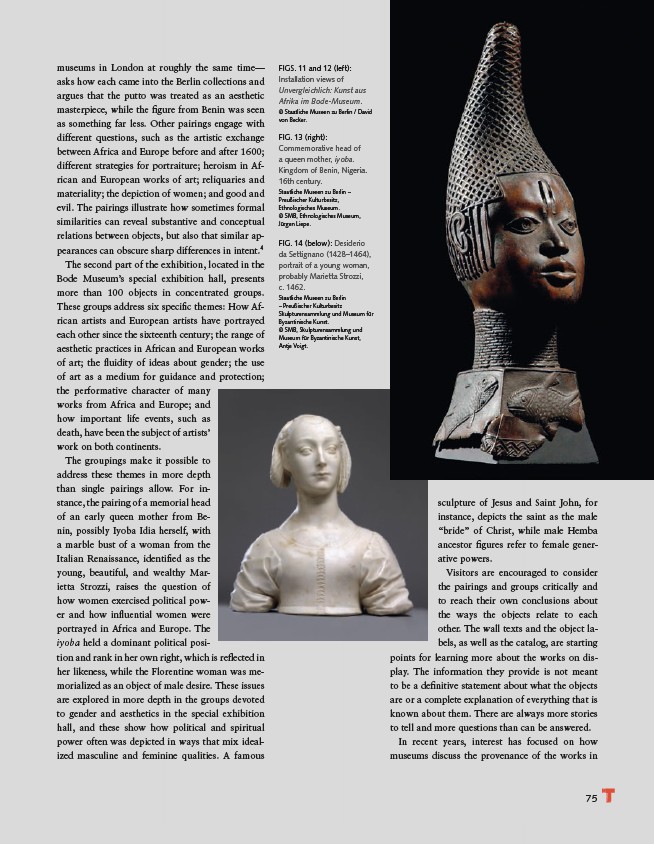
WESTERN NORTH AMERICA
sculpture of Jesus and Saint John, for
instance, depicts the saint as the male
“bride” of Christ, while male Hemba
ancestor fi gures refer to female generative
75
powers.
Visitors are encouraged to consider
the pairings and groups critically and
to reach their own conclusions about
the ways the objects relate to each
other. The wall texts and the object labels,
as well as the catalog, are starting
points for learning more about the works on display.
The information they provide is not meant
to be a defi nitive statement about what the objects
are or a complete explanation of everything that is
known about them. There are always more stories
to tell and more questions than can be answered.
In recent years, interest has focused on how
museums discuss the provenance of the works in
FIGS. 11 and 12 (left):
Installation views of
Unvergleichlich: Kunst aus
Afrika im Bode-Museum.
© Staatliche Museen zu Berlin / David
von Becker.
FIG. 13 (right):
Commemorative head of
a queen mother, iyoba.
Kingdom of Benin, Nigeria.
16th century.
Staatliche Museen zu Berlin –
Preußischer Kulturbesitz,
Ethnologisches Museum.
© SMB, Ethnologisches Museum,
Jürgen Liepe.
FIG. 14 (below): Desiderio
da Settignano (1428–1464),
portrait of a young woman,
probably Marietta Strozzi,
c. 1462.
Staatliche Museen zu Berlin
– Preußischer Kulturbesitz
Skulpturensammlung und Museum für
Byzantinische Kunst.
© SMB, Skulpturensammlung und
Museum für Byzantinische Kunst,
Antje Voigt.
museums in London at roughly the same time—
asks how each came into the Berlin collections and
argues that the putto was treated as an aesthetic
masterpiece, while the fi gure from Benin was seen
as something far less. Other pairings engage with
different questions, such as the artistic exchange
between Africa and Europe before and after 1600;
different strategies for portraiture; heroism in African
and European works of art; reliquaries and
materiality; the depiction of women; and good and
evil. The pairings illustrate how sometimes formal
similarities can reveal substantive and conceptual
relations between objects, but also that similar appearances
can obscure sharp differences in intent.4
The second part of the exhibition, located in the
Bode Museum’s special exhibition hall, presents
more than 100 objects in concentrated groups.
These groups address six specifi c themes: How African
artists and European artists have portrayed
each other since the sixteenth century; the range of
aesthetic practices in African and European works
of art; the fl uidity of ideas about gender; the use
of art as a medium for guidance and protection;
the performative character of many
works from Africa and Europe; and
how important life events, such as
death, have been the subject of artists’
work on both continents.
The groupings make it possible to
address these themes in more depth
than single pairings allow. For instance,
the pairing of a memorial head
of an early queen mother from Benin,
possibly Iyoba Idia herself, with
a marble bust of a woman from the
Italian Renaissance, identifi ed as the
young, beautiful, and wealthy Marietta
Strozzi, raises the question of
how women exercised political power
and how infl uential women were
portrayed in Africa and Europe. The
iyoba held a dominant political position
and rank in her own right, which is refl ected in
her likeness, while the Florentine woman was memorialized
as an object of male desire. These issues
are explored in more depth in the groups devoted
to gender and aesthetics in the special exhibition
hall, and these show how political and spiritual
power often was depicted in ways that mix idealized
masculine and feminine qualities. A famous